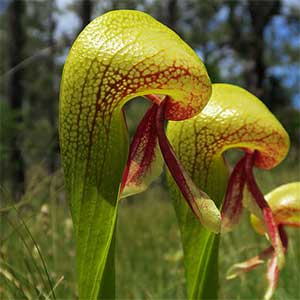Darlingtonia californica
Sarraceniaceae
California pitcher plant, cobra lily, cobraplant
pitcher-plant family
absent.
(henceforth referred to as pitchers) rosette-forming, alternate, developing into hollow tubes;
stipules absent;
petiole clasping, dilated;
blade green, yellow-green, reddish, or purplish, often distinctly red, pink, or green, purple-veined or -blotched, sometimes white-areolate, winged laterally along its length, usually prominently costate, surfaces of pitcher and hood glabrous or hairy and minutely glandular;
orifice with thickened, revolute rim;
hoods variously arranged in association with orifices.
with white areolae, 4–6(–10) dm, neck ca. 1 cm.
present or absent.
5–10 dm;
bracts yellowish, 1–3.5 cm.
1 or 2, bracteate, glabrous.
solitary flowers, arising from growing tip of rhizome.
sepals yellow-green, 3–6 cm;
petals reddish brown with larger veins darker, 3.5 cm;
stamens 10 mm;
filaments 5 mm;
abaxial anther sacs 6 mm, adaxial ones 4 mm;
ovary 1.5 × 0.5 cm at base, to 1.3 cm diam. at apex;
style 5 mm, lobes 3 × 1 mm.
bisexual, nodding;
perianth and androecium hypogynous;
hypanthium absent;
sepals 5;
petals 5, distinct;
stamens 15 or 50–100, distinct or slightly fascicled;
anthers laterally dehiscent;
pistils 1, 5-carpellate;
ovary superior, 5-locular;
placentation axile to parietal;
ovules anatropous, bitegmic, tenuinucellate;
styles 1, terminal;
stigmas 5, distal.
capsular, globose to ovoid or obconic, shallowly 5- or 10-lobed, tuberculate, dehiscence loculicidal.
3.5–4.5 × 1–2.5 cm.
2–3 × 1 mm.
400–1000, tan, irregularly clavate to reniform-obovate;
embryo straight;
endosperm copious, oily.
= 30.
Darlingtonia californica
Sarraceniaceae
Within California, Darlingtonia californica is disjunct from Del Norte County in the northwest to Nevada County southeasterly in the Sierra Nevada, and introduced in Humboldt and Mendocino counties. In Oregon, it occurs in the coastal lowlands and inland mountains of Curry and Josephine counties northward to Tillamook County. It is introduced on Vancouver Island in British Columbia, and in southern Washington. It may form relatively large stoloniferous colonies on mountain slopes or meadows and in coastal lowlands, or in shallow streams and seepage bogs. The flowers are initiated in the fall and overwinter in the bud stage, protected by the bracts. The fruits mature in late summer to fall, with seed dispersal continuing throughout the winter. The long papillae on the seeds allow flotation.
Darlingtonia californica is stunning in the wild, eagerly sought for cultivation, and difficult to grow outside its cool native range. It was discovered in 1841 on the Wilkes Expedition by the assistant botanist, W. D. Brackenridge, growing in a marsh bordering a tributary on the Sacramento River south of Shasta Peak. It is currently threatened by road building, draining, logging, ranching, drought, and unscrupulous collectors. Darlingtonia and some eastern American species of carnivorous plants have been transplanted into sites in northern California and the Pacific Northwest.
(Discussion copyrighted by Flora of North America; reprinted with permission.)
Genera 3, species 22 (2 genera, 12 species in the flora).
The North American pitcher plants are a fascinating group of carnivorous plants with leaves modified into tubular pitfall traps that attract, catch, and digest small invertebrate prey. The pitchers have no moving parts but contain downward-pointing hairs on the interior surfaces. The hoods keep out rainwater and prevent flying prey from escaping; only Sarracenia purpurea and S. rosea normally contain rainwater inside the pitchers.
Darlingtonia californica is found scattered in the Pacific Northwest (California and Oregon). Sarracenia occurs mainly in the southeastern United States, with one species (S. purpurea) occurring northward and westward across Canada to British Columbia, and naturalized in Switzerland, the British Isles, and Japan. Heliamphora Bentham, a tropical genus with about 15 species, is endemic to the Guayana Highlands of northern Brazil, western Guyana, and southern Venezuela. All species are characteristic of moist-to-wet, open, sunny, low-nutrient, acidic habitats.
The evolutionary origins and relationships of the Sarraceniaceae are obscure, and there is only one (highly questionable) fossil record (Li H. Q. 2005). Molecular data suggest Ericalean affinities (R. J. Bayer et al. 1996). Some authors have suggested that Heliamphora is primitive in the family (B. Maguire 1978) because its pitcher structure is less complex. All three genera have specializations, and their pitcher morphologies are likely affected by adaptations to their wet environments and carnivorous habits. Because we cannot reliably ascertain which taxa are primitive in this family, the genera and species are presented in alphabetic order.
(Discussion copyrighted by Flora of North America; reprinted with permission.)
1. Pitchers twisted through 90-270°, orifice facing ground; bracts usually 9, alternate along scape; stamens 15; styles terminating in 5 radially diverging, filiform arms; seeds papillate; Pacific Northwest. | Darlingtonia |
1. Pitchers not twisted, orifice not facing ground; bracts 3, usually appressed or adjacent to sepals; stamens 50-100; styles umbrella-shaped; seeds tuberculate to reticulate- tuberculate; e United States and s Canada. | Sarracenia |
- Local floras:
CA,
OR
- Local Web sites:
CalFlora,
CalPhotos,
Flora NW,
PNW Herbaria
WildflowerSearch
iNaturalist (observations)
- LBJ Wildflower Center
- SEINet
- Plants of the World Online
- Encyclopedia of Life
- Wikipedia
- Google Image Search


